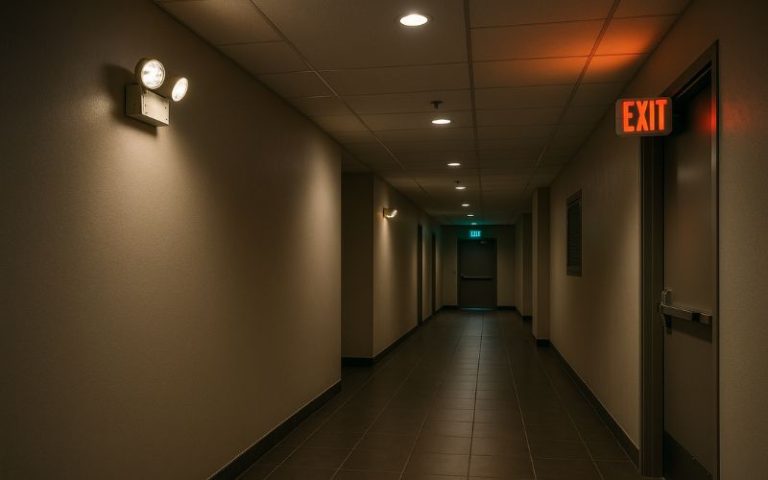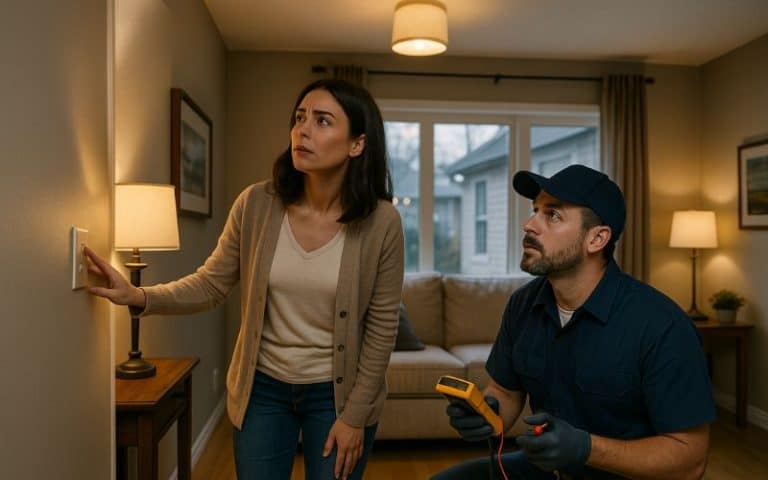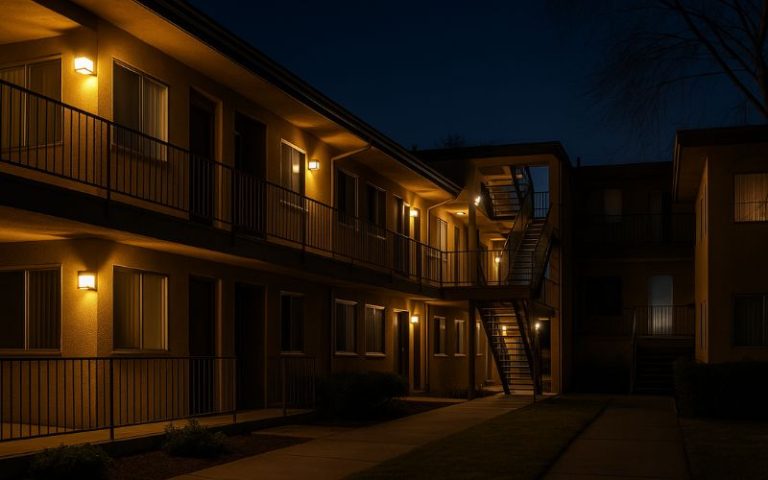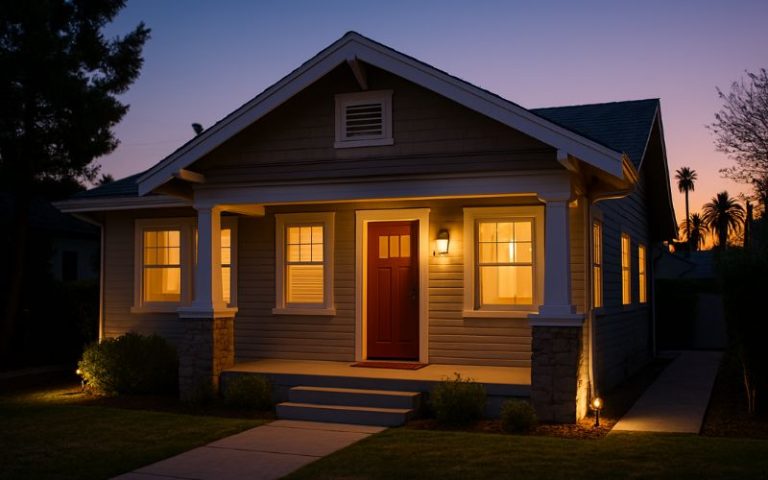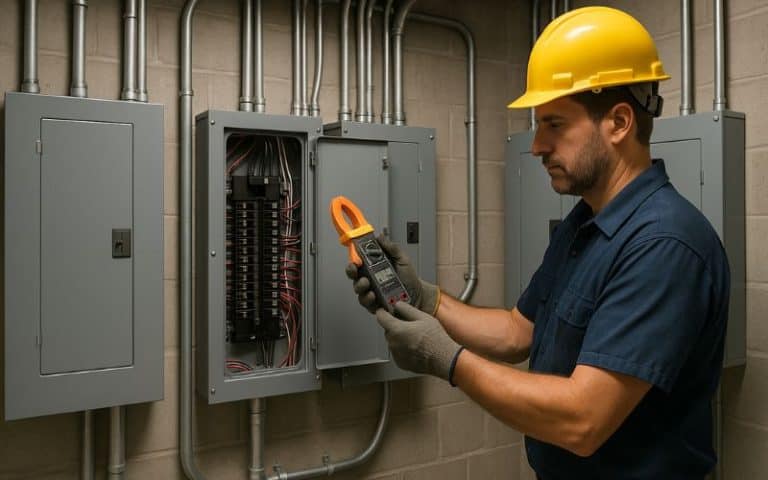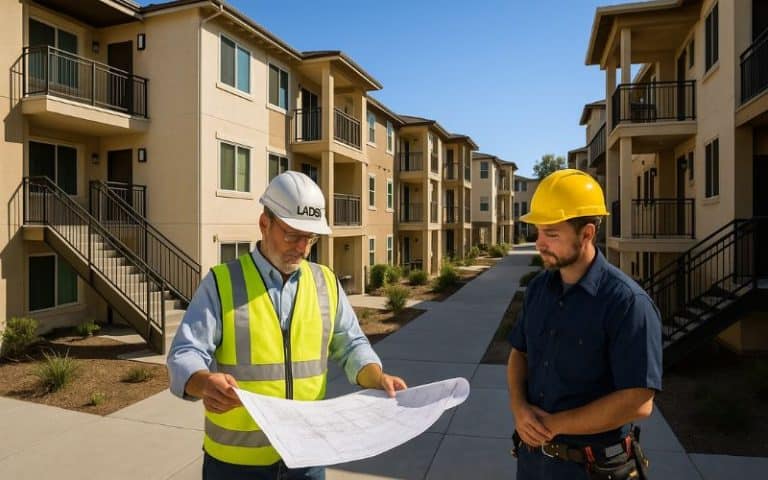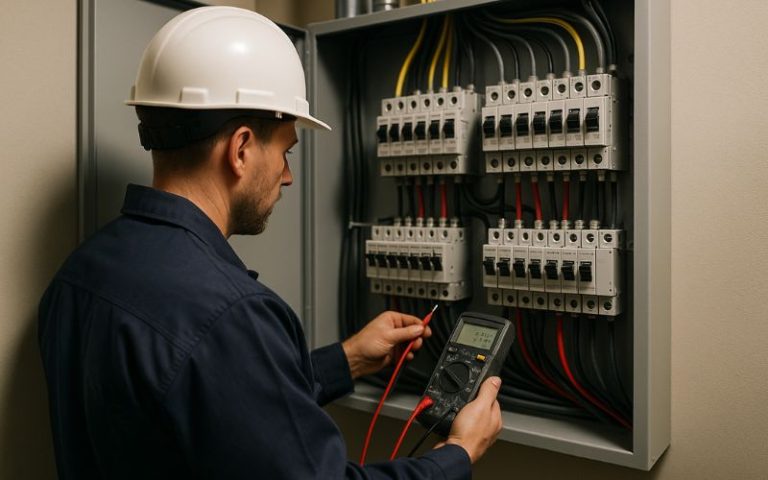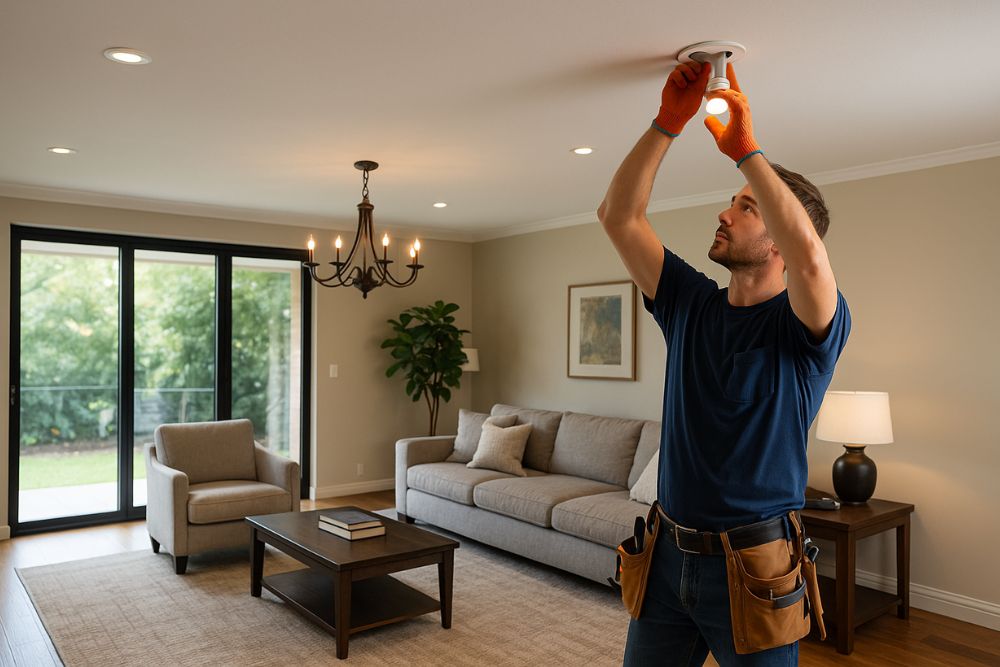
Indoor Lighting Installation in Los Angeles: A Complete Guide for Homes and Multi-Unit Properties
Why Indoor Lighting Matters More Than You Think
When most people think about electrical upgrades, they picture breaker panels, wiring, or EV chargers. But for both homeowners and property managers in Los Angeles, indoor lighting is one of the most impactful electrical improvements you can make. It’s not just about being able to see at night — it’s about safety, functionality, comfort, and property value.
Safety and Security
Proper indoor lighting plays a critical role in safety. In multi-unit properties, poorly lit stairwells or hallways can become liability traps. For homeowners, dark entryways or basements create tripping hazards. Adequate lighting is one of the simplest, most effective ways to prevent accidents and keep tenants or family members safe.
👉 Related: Electrical Switches and Outlets in Los Angeles
Tenant Satisfaction and Comfort
For property managers, lighting has a direct effect on tenant satisfaction. Nobody wants to live in a dim, shadowy apartment. Bright, energy-efficient lighting makes units feel more spacious and inviting. It also reduces complaints about “bad lighting,” which are among the top frustrations for renters.
Homeowners, too, see lighting as a way to shape their lifestyle. From cozy living rooms with warm dimmers to bright kitchens with task lighting, the right design creates comfort and personality in a home.
Aesthetic Appeal and Property Value
Lighting is one of the few upgrades that can instantly modernize a space without major renovations. For example, replacing outdated fluorescent fixtures in an apartment kitchen with sleek recessed LEDs immediately makes the unit feel higher-end.
For property managers, that translates into higher rents and fewer vacancies. For homeowners, it increases resale value and day-to-day enjoyment.
Energy Efficiency and Cost Savings
In Los Angeles, where energy costs are high, efficient lighting is more than a luxury — it’s a financial strategy. LED technology consumes up to 75% less energy than incandescent bulbs and lasts 25 times longer. For multi-unit properties, that’s a huge reduction in common area operating costs.
👉 Related: LED Lighting Upgrades for Los Angeles Commercial Properties
Compliance with Codes and Insurance Requirements
Finally, proper lighting helps with code compliance. Emergency lighting, stairwell illumination, and hallway fixtures are all regulated under California’s building and fire codes. Failing to meet these requirements can put property managers at risk of fines, insurance complications, or even REAP penalties.
In short, indoor lighting is not an afterthought. It’s a strategic upgrade that impacts safety, comfort, compliance, and long-term financial health.
Common Indoor Lighting Options in Los Angeles Homes and Apartments
The next question is: what kind of indoor lighting is right for your property? Los Angeles buildings vary widely — from 1920s Hollywood apartments to modern high-rises and single-family homes. Each type of property benefits from different lighting strategies.
Here are the most common options property managers and homeowners should consider:
1. Recessed Lighting
Recessed, or “can lights,” are one of the most popular choices in Los Angeles renovations. They provide a clean, modern look while delivering excellent general illumination. In multi-unit apartments, recessed lighting in kitchens and living rooms instantly updates the feel of the space.
- Pros: Modern aesthetic, wide coverage, energy-efficient with LED.
- Cons: Requires professional installation and adequate ceiling clearance.
👉 Related: Pot Light Installation – How Much Does It Cost?
2. Chandeliers and Pendant Lights
For dining rooms, lobbies, or entryways, chandeliers and pendants make a statement. They add character and serve as a focal point. Many Los Angeles luxury apartments use oversized pendants in lobbies to create a sense of elegance.
- Pros: Decorative, customizable, dramatic impact.
- Cons: Needs correct ceiling support and professional wiring.
3. Track Lighting
Track lighting is a versatile option that works well in both residential and commercial spaces. It allows multiple adjustable fixtures on one track, making it perfect for highlighting artwork, retail displays, or kitchens.
- Pros: Flexible, modern, directional lighting.
- Cons: Can look industrial if not carefully designed.
4. Under-Cabinet Lighting
In kitchens, under-cabinet lights improve both aesthetics and function. They provide excellent task lighting for cooking and create a high-end look. Tenants appreciate the practicality, while homeowners love the design appeal.
- Pros: Increases functionality, stylish, energy-efficient.
- Cons: Requires wiring, not ideal as the sole source of light.
👉 Related: How to Install Under Cabinet Lighting
5. Wall Sconces
Wall sconces are perfect for hallways, stairwells, or bedrooms. They provide softer, diffused lighting and can double as decorative accents. In multi-unit buildings, sconces are often used to add warmth to otherwise plain corridors.
- Pros: Space-saving, decorative, softer illumination.
- Cons: Limited coverage — best as supplementary lighting.
6. Smart Lighting Systems
Smart lighting is becoming a standard expectation in modern Los Angeles apartments. These systems allow tenants or homeowners to control lights via smartphone or voice assistants. Property managers can also program common area lighting for efficiency and security.
- Pros: High tenant appeal, energy savings, customizable.
- Cons: Higher upfront cost, requires Wi-Fi infrastructure.
Indoor Lighting for Multi-Unit and Commercial Properties
While homeowners focus on style and comfort, property managers and commercial landlords in Los Angeles have a different set of priorities: safety, efficiency, compliance, and tenant satisfaction across many units or shared spaces. Indoor lighting becomes less about personal taste and more about creating systems that scale, save money, and meet regulatory requirements.
Hallways and Stairwells: Safety First
Hallways and stairwells are high-traffic areas where lighting is not just optional — it’s legally required. California building codes mandate adequate illumination for all exits, staircases, and egress paths. Poor lighting in these areas is one of the top liability risks for property managers, since it increases the chance of tenant falls or accidents.
- Best Solutions: LED strip lighting, wall sconces, and recessed fixtures.
- Why It Matters: Bright, even light improves safety, meets code, and reduces complaints.
👉 Related: Electrical Code Compliance in Los Angeles
Lobbies and Common Areas: First Impressions Count
In multi-unit apartments and commercial buildings, the lobby sets the tone. Bright, stylish lighting makes the space feel welcoming and secure. Property managers who invest in lobby upgrades often see improved tenant satisfaction and property value.
- Best Solutions: Chandeliers, pendant lights, and layered lighting with dimmers.
- Why It Matters: Enhances curb appeal, attracts higher-quality tenants, boosts retention.
Offices and Workspaces: Productivity and Comfort
For commercial properties, lighting directly impacts productivity. Studies show that well-lit offices improve employee focus and reduce fatigue. Los Angeles businesses increasingly demand lighting that mimics natural daylight, particularly in creative industries.
- Best Solutions: LED panel lights, adjustable task lighting, and smart systems with tunable white light.
- Why It Matters: Supports tenant businesses, reduces energy costs, and increases lease value.
Parking Garages and Basements: Security and Efficiency
Indoor parking structures and basements often get overlooked, but lighting here is critical for safety and liability. In Los Angeles, where security is a top concern for tenants, dark parking garages can lead to serious risks.
- Best Solutions: Motion-activated LED flood lights.
- Why It Matters: Enhances tenant security, reduces electricity usage, discourages vandalism.
👉 Related: Outdoor Lighting Installation Services
Smart Lighting for Multi-Unit Properties
Smart lighting systems aren’t just for luxury homes. Property managers are using them to control common area lighting remotely, set schedules, and reduce wasted energy. In large complexes, automated lighting cuts operating costs while maintaining safety and compliance.
For example:
- Timed Lighting: Ensures hallways and stairwells are lit during peak hours.
- Motion Sensors: Reduce usage in rarely used storage rooms or utility areas.
- Centralized Control: Allows managers to oversee lighting across multiple buildings.
Energy Savings for Property Managers
Lighting is one of the largest contributors to energy bills in multi-unit and commercial properties. By upgrading to LEDs and smart controls, property managers can cut costs dramatically. According to the U.S. Department of Energy, LED retrofits typically reduce lighting costs by 50–70%.
In a 100-unit building, that can mean thousands of dollars in savings each year — while also reducing maintenance, since LEDs last 10+ years.
👉 Related: Commercial Electrical Services in Los Angeles
The Bottom Line for Property Managers: Indoor lighting isn’t just about looks. It’s about meeting code, keeping tenants safe, and cutting operating costs. A thoughtful lighting plan pays for itself in reduced liability, improved tenant retention, and long-term property value.
Electrical Considerations Before Installing Indoor Lighting
Indoor lighting may look simple once it’s installed, but behind every fixture is a network of wiring, circuits, and safety requirements that must be addressed first. This is where property managers and homeowners in Los Angeles often run into trouble. Installing new lighting without considering the electrical infrastructure can lead to overloaded circuits, failed inspections, and even safety hazards.
One of the most important steps before adding or upgrading lighting is performing a load calculation. This process determines how much electrical demand your property can handle. Older apartment buildings in Los Angeles, many built before modern code standards, may already be operating near capacity. Adding new recessed lights, chandeliers, or smart systems without checking the load could trip breakers or put tenants at risk of outages. For larger complexes, sub-panels may need to be installed to distribute the added demand more evenly.
Another critical factor is wiring condition. Many LA properties still have outdated wiring systems, including aluminum or even knob-and-tube wiring. These older systems aren’t designed to handle modern lighting loads, and attempting to install new fixtures on them can be dangerous. In some cases, a wiring upgrade is necessary before any lighting work begins. This is why licensed electricians often recommend inspections before committing to a project.
Permits and code compliance are also unavoidable. Los Angeles has strict electrical codes that dictate how and where lighting can be installed. For example, kitchens and bathrooms may require GFCI-protected circuits, while stairwells and hallways must meet minimum illumination standards. Skipping permits may seem like a shortcut, but it almost always backfires when an inspector visits, a tenant complains, or an insurance company investigates after an incident.
DIY installations are particularly risky. While it may be tempting to save money by installing a light fixture yourself, most building owners underestimate the complexity involved. Even a simple chandelier install requires proper anchoring, correct wiring, and verification that the circuit can handle the load. In commercial and multi-unit settings, unauthorized work can result in fines and failed inspections. For property managers, that risk is far more expensive than hiring a licensed electrician from the start.
In short, installing indoor lighting isn’t just about choosing the right fixtures — it’s about making sure the electrical system behind the walls is safe, compliant, and capable of supporting the upgrade. This is where professionals like RG Electric provide not just installation, but peace of mind.
The ROI of Professional Indoor Lighting Installation in Los Angeles
When property managers or homeowners consider upgrades, lighting often gets overlooked in favor of flashier renovations like new appliances or flooring. But professional indoor lighting installation in Los Angeles delivers a return on investment that goes beyond appearances.
For property managers, one of the biggest returns comes from tenant retention. Apartments with modern, energy-efficient lighting feel safer, brighter, and more welcoming. Tenants are more likely to renew leases when they feel comfortable in their living environment. Even small upgrades, like replacing outdated hallway fixtures with LED sconces, can dramatically improve tenant satisfaction and reduce turnover costs.
There’s also the direct impact on property value. A well-lit building photographs better, shows better, and appraises higher. Realtors often emphasize lighting as one of the top features buyers notice when walking into a home or rental unit. For commercial properties, good lighting design can make offices more desirable to businesses seeking a professional, productive environment.
Energy savings represent another layer of ROI. Switching from incandescent or fluorescent lighting to LED can cut energy consumption by half or more. In a multi-unit building, where lighting runs 24/7 in hallways, stairwells, and garages, those savings add up to thousands of dollars per year. Reduced maintenance costs are part of the equation too, since LEDs last significantly longer, meaning fewer replacements and less labor.
Insurance and liability protection provide a quieter but equally important return. Properties with compliant, professionally installed lighting systems are less likely to face claims from accidents, fires, or code violations. Insurers reward buildings with strong safety records, sometimes offering better premiums. Conversely, cutting corners on lighting can increase liability exposure and leave property managers vulnerable to lawsuits.
Finally, there’s the reputational ROI. In Los Angeles’ competitive rental and commercial property markets, reputation matters. Tenants talk, online reviews spread quickly, and buildings with poor lighting often get labeled as unsafe or poorly maintained. On the flip side, modern lighting upgrades signal that a property manager or homeowner cares about safety, comfort, and quality of life. That perception builds trust, which is invaluable for long-term success.
When all of these factors are considered, tenant retention, energy savings, reduced liability, and improved property value, indoor lighting proves itself as one of the highest-return investments property managers and homeowners can make. It’s not just about flipping a switch. It’s about creating safer, more efficient, and more appealing spaces that pay dividends for years to come.
Conclusion: Call RG Electric for Indoor Lighting Installation in Los Angeles
Indoor lighting installation isn’t just another item on a renovation checklist. In Los Angeles, where tenant expectations are high and building codes are strict, lighting upgrades are one of the most effective ways to improve safety, reduce liability, and increase property value.
For property managers, the benefits are clear: brighter hallways and stairwells mean fewer accidents and fewer complaints. Modern lobby lighting makes a strong first impression and helps retain quality tenants. Energy-efficient LEDs and smart systems cut costs year after year, while also showing inspectors and insurers that your property is up to code.
For homeowners, indoor lighting is one of the most affordable ways to transform a space. A new chandelier in the dining room, recessed LEDs in the kitchen, or under-cabinet lighting can make an older home feel brand new. Beyond aesthetics, proper lighting ensures safety for your family, keeps utility bills under control, and supports the long-term value of your home.
The key is making sure these upgrades are done right. DIY shortcuts and unpermitted work might seem like a way to save money, but they often end in failed inspections, code violations, or worse, unsafe electrical conditions. Partnering with a licensed Los Angeles electrician ensures that your lighting isn’t just beautiful, but also safe, compliant, and built to last.
At RG Electric, we specialize in helping both homeowners and property managers get the most from their indoor lighting. From design consultation to installation and maintenance, our team ensures every project meets code, maximizes efficiency, and enhances the space it serves. Whether you’re upgrading one room or modernizing an entire multi-unit complex, we bring the expertise and professionalism Los Angeles properties demand.
📞 Call RG Electric today at (323) 521-5131 or request a Free Estimate. Let us help you light up your property the right way, safely, beautifully, and with long-term value in mind.
Because when it comes to indoor lighting in Los Angeles, the right installation makes all the difference.

